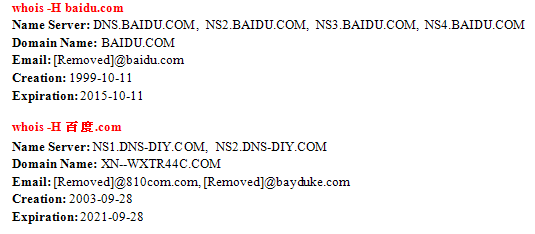This is the final part of a three-part blog based on my paper for AVAR 2012 that discusses the security challenges involved in adopting two relatively new technologies, namely, Internet Protocol Version 6 and Internationalized Domain Names.
Continuing from the second part of my paper..
Social Engineering. Malware authors/Spammers/Phishers who now have a larger character set to play with are likely to register domains resembling an original site to trick users into divulging information.
Fig.10 below shows the domain information for baidu.com and an IDN equivalent. Considering that the name servers, the e-mail address used to register the domain, etc, do not match, even security savvy users are likely to find it tricky to validate a URL from such IDNs before visiting it.

Fig.10: whois information on the original baidu.com and the squatted IDN version
Thanks to social networking sites like Facebook, twitter etc., which enable instant sharing of information among millions of users from different backgrounds, uncommon URLs could invoke a click from curious users even if they don’t recognise the character set. Malware campaigns such as these, though short lived, could still cause enough damage globally.

Fig.11: Representative example of an attack based on socially engineered IDNs
Matching Incongruence
URL scanners could focus more on consistency or the lack thereof while dealing with phishing and malware related URLs arriving from IDNs. Language mismatch between the message body of the e-mail and the URL, or the URL and the contents of the page that the URL points to, can be deemed suspicious.
Restrictions may be imposed on visiting IDNs which don’t match a user-defined list of allowed languages. Similarly, domains created by combining visually similar characters from different character sets can also be curbed. Popularly known as a Homograph attack, most common browsers already defend users against such threats. While this protection is only limited to within the browser, it can be extended to protect e-mail, social networking and other layers as well [12].
Fig.12 below shows two domains, one created entirely using the Latin character set and the other using a combination of Latin and Cyrillic character sets. Though both domains visually appear to be similar, their Puny Code representation proves otherwise.

Fig.12: Example of two visually similar domains and their Puny Code representation [13]
Security vendors could also continue existing practices of assigning a poor reputation to domains that originate from certain high-risk countries. Such domains are usually created due to nonexistent or inadequate cyber laws in the host country, which result in malware authors abusing them. Reputation can also be assigned to registrars of IDNs based on their commitment to handling abuse reports, enforcement and verification of registrant details, ease of registering domains in bulk, etc.
A solution to address the e-mail spam problem could involve creating a white list of registered mail servers. The Ipv6whitelist.eu project, for example, works on the assumption that all computers send out spam, unless they have been previously registered on the white list [14]. In addition, since there are few mail servers catering to a significantly large user base, one could argue that e-mail could continue using IPv4, which could breath new life into the practice of IP blacklisting, at least for e-mail spam.
There is a Certainty in Uncertainty
The implications of the transition from IPv4 to IPv6, and the introduction of IDNs, are bound to be of major significance to the Internet infrastructure. These changes engender the continuous growth of the Internet by accommodating an increasing number of inter-connected devices, and variegated foreign languages.
As with any change, given the absence of a crystal ball, the move to these new technologies involves risk.Without doubt spammers, phishers and malware authors, seeking to make a quick buck, will exploit the larger attack surface provided by a vastly increased IP address space and language diversity via IDNs. We in the AV industry must take cognizance of this to determine the security implications and forge robust solutions.
As discussed in this paper, the new technologies will put pressure on current methods to counter spam, phishing and malicious URLs, especially where reputation is of prime importance. Fortunately, AV vendors have generally been able to adapt to the regular inflow of new issues, with new responses for these constantly on the anvil.
The changes about to be witnessed and the solutions proposed are likely to have security companies relying heavily on aggressive heuristics and policy-based restrictions, which could increase the number of false positives. However in corporate environments, rules can be configured to suit the risk appetite of the user in question.
Things are about to get a whole lot more difficult. However, greater vigilance, user education, and as ever, timely security industry data sharing, will help in controlling the fallout. The challenge is indeed a major one, but it is certainly not insurmountable. we.can.deal.with.it
References:
[12] http://en.wikipedia.org/wiki/IDN_homograph_attack#Defending_against_the_attack
[13] Information on http://en.wikipedia.org/wiki/IDN_homograph_attack
[14] Information on http://www.ipv6whitelist.eu
Lokesh Kumar
K7 Threat Control Lab
If you wish to subscribe to our blog, please add the URL provided below to your blog reader:
https://labs.k7computing.com/feed/









